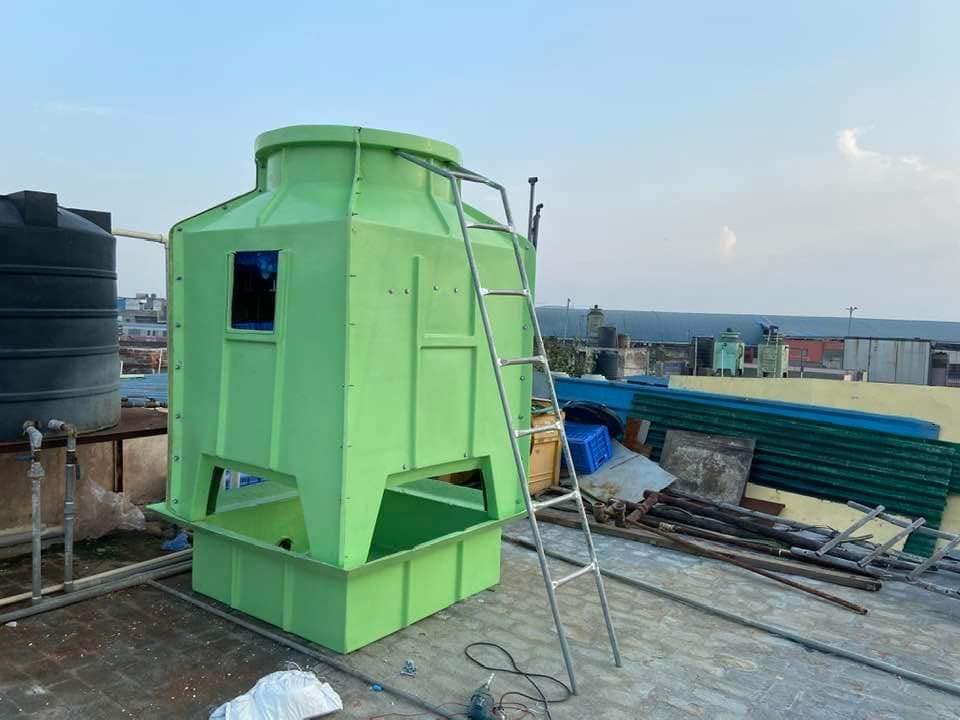Selecting the right cooling tower for high-temperature applications (e.g., steel plants, refineries, power plants, or chemical processing) requires careful consideration of heat load, water quality, ambient conditions, and system efficiency. Below is a step-by-step guide:
1. Determine Key Requirements
- Heat Load (BTU/hr or kW):
Calculate the amount of heat to be rejected (based on process cooling needs). - Inlet Water Temperature (°C/°F):
High-temperature applications (e.g., >50°C or 122°F) need robust materials. - Outlet Water Temperature:
Defines cooling range (ΔT) – critical for tower sizing. - Flow Rate (m³/hr or GPM):
Required water circulation capacity.
2. Choose the Right Type of Cooling Tower
For high temperatures, consider these types:
A. Induced Draft Cooling Towers (Counterflow or Crossflow)
- Best for: large heat loads (e.g., power plants, refineries).
- Why?
- High thermal efficiency due to better air-water contact.
- Handles high temperatures (up to 65°C or 150°F+).
- Fan at the top reduces recirculation of hot air.
B. Forced Draft Cooling Towers
- Best for: Medium-high temperature industrial processes.
- Why?
- Blower at the base pushes air forcefully, improving cooling.
- Compact but may consume more energy.
C. Hybrid Cooling Towers (Wet + Dry Cooling)
- Best for: Extreme heat (e.g., steel mills, cogeneration plants).
- Why?
- Combines evaporative + air cooling for efficiency.
- Reduces water usage while handling high temps.
D. Closed-Circuit Cooling Towers (Fluid Coolers)
- Best for: Corrosive/contaminated water (e.g., chemical plants).
- Why?
- No direct water-air contact; prevents scaling/fouling.
- Handles high temps with glycol mixtures if needed.
E. Natural Draft Cooling Towers
- Best for: Very large power plants (e.g., nuclear).
- Why?
- No fans → low energy use.
- Handles massive heat loads but requires tall structures.
3. Material Selection (Critical for High Temp)
- Fill Media:
- PVC: Good for <60°C.
- PP (Polypropylene): Resists higher temps (up to 80°C).
- Stainless Steel/Ceramic: For >80°C (e.g., steel industry).
- Casing & Structure:
- FRP (Fiberglass): Standard for corrosion resistance.
- Galvanized Steel/Stainless Steel: For extreme heat/corrosion.
4. Consider Ambient Conditions
- Hot & Dry Climates:
- Higher evaporation rate → more water consumption.
- Hybrid or closed-circuit towers help conserve water.
- Humid Climates:
- Evaporative cooling less efficient → may need larger towers.
5. Water Quality & Treatment
- High temps increase scaling, corrosion, and biological growth.
- Solutions:
- Use scale inhibitors and biocides.
- Choose closed-loop systems if water is contaminated.
- Install filtration & softening systems.
6. Energy Efficiency & Cost Factors
- Variable Frequency Drives (VFDs): Save energy by adjusting fan speed.
- Approach Temperature: Closer approach = larger tower (higher cost).
- Lifecycle Cost: Balance upfront cost vs. long-term savings.
7. Industry-Specific Recommendations
| Industry | Preferred Cooling Tower Type | Key Considerations |
| Steel Mills | Hybrid or Induced Draft (SS) | Extreme heat (100°C+), corrosion-resistant materials |
| Power Plants | Natural Draft / Induced Draft | Massive heat loads, long-term reliability |
| Oil & Gas Refineries | Forced Draft / Closed-Circuit | Chemical resistance, high-pressure cooling |
| Chemical Processing | Closed-Circuit (PP/SS) | Avoid contamination, handle corrosive fluids |
| Data Centres | Induced Draft (Crossflow) | Reliable, moderate-high cooling needs |
For high-temperature applications, induced draft or hybrid cooling towers with stainless steel/ceramic components are often the best choice. Key factors include:
Heat load & flow rate → Sizing
Material durability → Stainless steel/PP for >60°C
Water treatment → Prevent scaling/corrosionEnergy efficiency → VFDs, hybrid cooling
